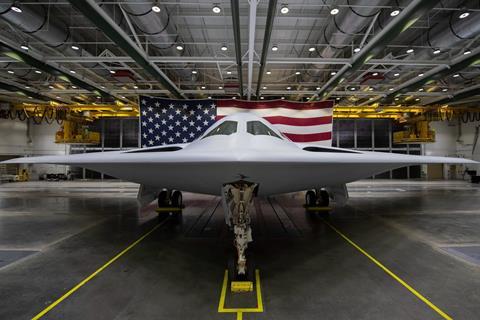The US Air Force (USAF) has approved low-rate production of the service’s next-generation stealth bomber.
The milestone comes just days after the Northrop Grumman B-21 Raider completed its second known test flight, although neither the USAF or Northrop are confirming how many sorties the experimental flying-wing type has undertaken.
“Production of the B-21 stealth bomber is moving forward,” said under secretary of defense William LaPlante on 22 January.

LaPlante, who serves as the Pentagon’s top acquisitions official, apparently gave approval for Northrop to begin low-rate initial production on the Raider sometime in the autumn of 2023. That is in-line with a prediction made by Northrop chief executive Kathy Warden on 26 October during the company’s third-quarter earnings call.
“First flight is a milestone that the air force is looking to achieve before they make that [LRIP] award,” Warden said.
A joint Northrop-USAF test team completed that first B-21 flight just days later on 10 November, launching from the site in Palmdale, California known as Plant 42 where Northrop is developing the secretive aircraft. Flight testing is being managed by the USAF’s 412th Test Wing at nearby Edwards AFB.
The USAF has confirmed another flight took place on 17 January. No other test flights have been revealed publicly.
“Based on the results of ground and flight tests and the team’s mature plans for manufacturing, I gave the go-ahead to begin producing B-21s,” LaPlante says.
The value of the initial LRIP contract has not yet been disclosed. LaPlante’s comments were first reported by Bloomberg.
Northrop has previously said it has six B-21 airframes in various stages of production, including the one example currently known to be flying.
Although that flying testbed is considered an experimental prototype, Northrop previously said it considers the design to be a “production representative aircraft” – with minimal design changes anticipated for the production model.
The USAF plans to purchase at least 100 B-21s, with the type ultimately replacing the service’s Boeing B-1B and Northrop B-2 bombers.
“The B-21 will provide our nation with a strategic asset capable of penetrating enemy air defences in highly contested environments and striking targets anywhere in the world,” the air force says.
The service expects Boeing B-52s will continue flying for several decades alongside the new Raider fleet. It plans to modernise the Cold War-era heavy B-52 bombers, which will then be designated B-52Js.


























